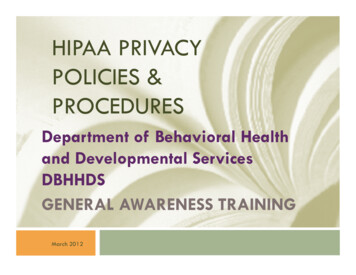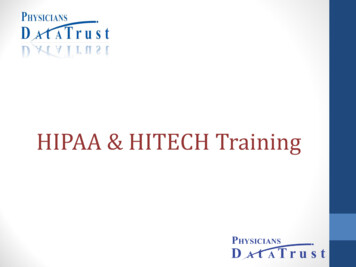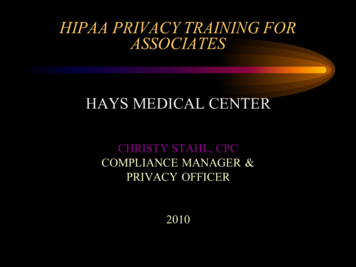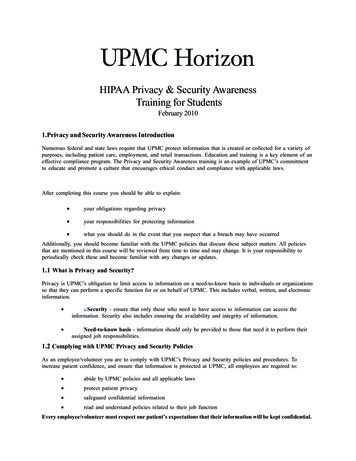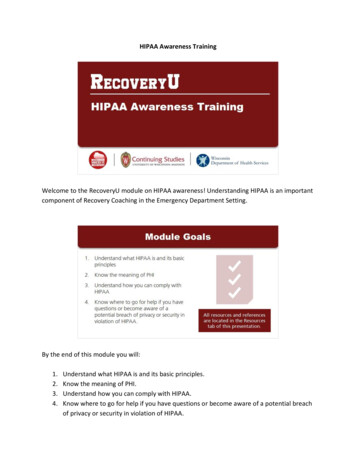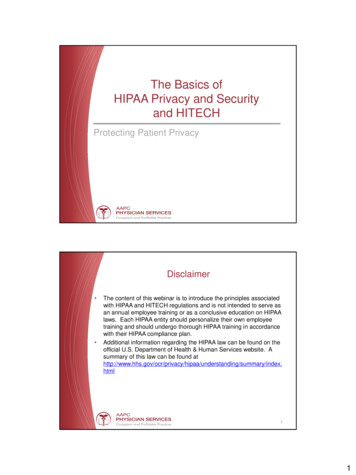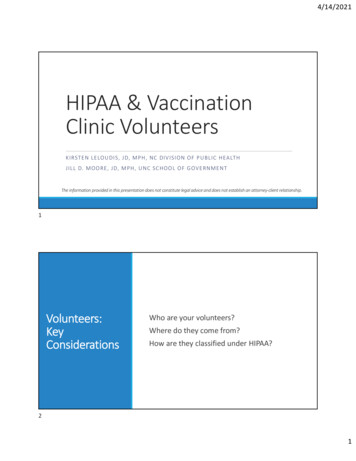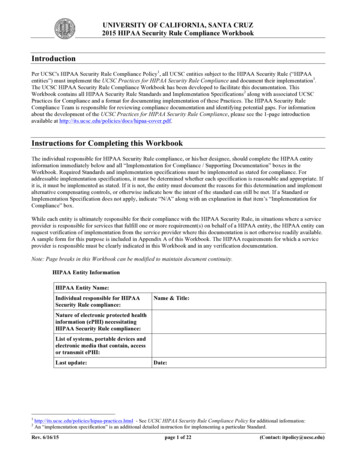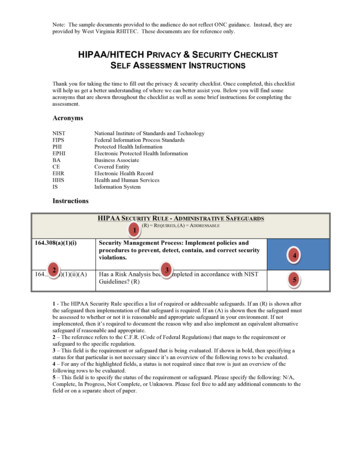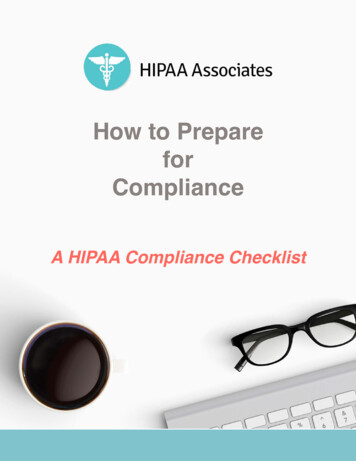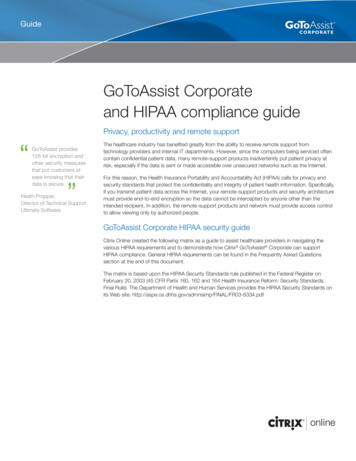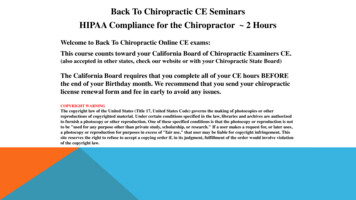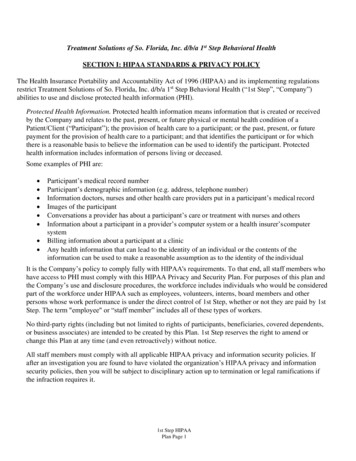
Transcription
Treatment Solutions of So. Florida, Inc. d/b/a 1st Step Behavioral HealthSECTION I: HIPAA STANDARDS & PRIVACY POLICYThe Health Insurance Portability and Accountability Act of 1996 (HIPAA) and its implementing regulationsrestrict Treatment Solutions of So. Florida, Inc. d/b/a 1st Step Behavioral Health (“1st Step”, “Company”)abilities to use and disclose protected health information (PHI).Protected Health Information. Protected health information means information that is created or receivedby the Company and relates to the past, present, or future physical or mental health condition of aPatient/Client (“Participant”); the provision of health care to a participant; or the past, present, or futurepayment for the provision of health care to a participant; and that identifies the participant or for whichthere is a reasonable basis to believe the information can be used to identify the participant. Protectedhealth information includes information of persons living or deceased.Some examples of PHI are: Participant’s medical record numberParticipant’s demographic information (e.g. address, telephone number)Information doctors, nurses and other health care providers put in a participant’s medical recordImages of the participantConversations a provider has about a participant’s care or treatment with nurses and othersInformation about a participant in a provider’s computer system or a health insurer’s computersystemBilling information about a participant at a clinicAny health information that can lead to the identity of an individual or the contents of theinformation can be used to make a reasonable assumption as to the identity of the individualIt is the Company’s policy to comply fully with HIPAA's requirements. To that end, all staff members whohave access to PHI must comply with this HIPAA Privacy and Security Plan. For purposes of this plan andthe Company’s use and disclosure procedures, the workforce includes individuals who would be consideredpart of the workforce under HIPAA such as employees, volunteers, interns, board members and otherpersons whose work performance is under the direct control of 1st Step, whether or not they are paid by 1stStep. The term "employee" or “staff member” includes all of these types of workers.No third-party rights (including but not limited to rights of participants, beneficiaries, covered dependents,or business associates) are intended to be created by this Plan. 1st Step reserves the right to amend orchange this Plan at any time (and even retroactively) without notice.All staff members must comply with all applicable HIPAA privacy and information security policies. Ifafter an investigation you are found to have violated the organization’s HIPAA privacy and informationsecurity policies, then you will be subject to disciplinary action up to termination or legal ramifications ifthe infraction requires it.1st Step HIPAAPlan Page 1
SECTION 1: Responsibilities as Covered EntityI. Privacy OfficerThe Human Resources Director will be the HIPAA Privacy Officer for 1st Step. The Privacy Officer willbe responsible for the development and implementation of policies and procedures relating to privacy,including but not limited to this Privacy Policy and the Company’s use and disclosure procedures. ThePrivacy Officer will also serve as the contact person for participants who have questions, concerns, orcomplaints about the privacy of their PHI.II. Incident Response TeamThe Incident Response Team is comprised of the CEO, COO, Site Managers and additional membersdeemed appropriate on an ad hoc basis in the reasonable judgment of the Privacy Officer. In the event of asecurity incident results in a wrongful disclosure of PHI, the Privacy Officer, in conjunction with theIncident Response Team will take appropriate actions to prevent further inappropriate disclosures. Inaddition, Human Resources and Legal may be consulted as part of the review team to assist in the reviewand investigation of privacy incidents when required. If the Privacy Officer and Incident Response Teamhave not resolved the incident, the Privacy Officer shall involve anyone determined to be necessary to assistin the resolution of the incident. If participants need to be notified of any lost/stolen PHI, the PrivacyOfficer will send PHI Theft/Loss Disclosure Letters to all possible affected individuals.III. Workforce TrainingIt is the Company’s policy to train all members of its workforce who have access to PHI on its privacypolicies and procedures. All staff members receive HIPAA training. Whenever a privacy incident hasoccurred, the Privacy Officer in collaboration with management will evaluate the occurrence to determinewhether additional staff training is in order. Depending upon the situation, the Privacy Officer maydetermine that all staff should receive training that is specific to the privacy incident. The Privacy Officerwill review any privacy training developed as part of a privacy incident resolution to ensure the materialsadequately address the circumstances regarding the privacy incident and reinforce the Company’s privacypolicies and procedures.IV. SafeguardsThe Company has established technical and physical safeguards to prevent PHI from intentionally orunintentionally being used or disclosed in violation of HIPAA's requirements. Technical safeguards includelimiting access to information by creating computer firewalls. Physical safeguards include locking doors orfiling cabinets and periodically changing door access codes. Additionally, all staff members can only accessPHI by using their own login information.Firewalls ensure that only authorized employees will have access to PHI, that they will have access to onlythe minimum amount of PHI necessary for their job functions, and that they will not further use or disclosePHI in violation of HIPAA's privacy rules.1st Step HIPAAPlan Page 2
Data Storage / Backup / Remote AccessCurrently all data in the local data center is backed up using industry standards with off site storage ofmedia. 1st Step currently utilizes technology that allows the IT team to quickly remove, disable and startstaff member access to PHI.V. Privacy NoticeThe Privacy Officer is responsible for developing and maintaining a notice of the Company’s privacypractices that describes: the uses and disclosures of PHI that may be made by the Company; the individual's rights; and the Company's legal duties with respect to the PHI.The privacy notice will inform participants that the Company will have access to PHI. The privacy noticewill also provide a description of the Company’s complaint procedures, the name and telephone number ofthe contact person for further information, and the date of the notice.The notice of privacy practices will be individually delivered to all participants: on an ongoing basis, at the time of an individual's enrollment into a Company program or at the time oftreatment and consent; and within 60 days after a material change to the notice.The Company will also provide notice of availability of the privacy notice at least once every three years.VI. ComplaintsThe Privacy Officer will be the Company's contact person for receiving complaints. The Privacy Officer isresponsible for creating a process for individuals to lodge complaints about the Company's privacyprocedures and for creating a system for handling such complaints. A copy of the complaint form shall beprovided to any participant upon request.VII. Sanctions for Violations of Privacy PolicySanctions for using or disclosing PHI in violation of this HIPAA Privacy Plan will be imposed inaccordance up to and including termination.VIII. Mitigation of Inadvertent Disclosures of Protected Health Information1st Step shall mitigate, to the extent possible, any harmful effects that become known to it because of a useor disclosure of an Participant’s PHI in violation of the policies and procedures set forth in this Plan. As aresult, if an employee becomes aware of a disclosure of protected health information, either by a staffmember of the Company or an outside consultant/contractor that is not in compliance with this Policy,immediately contact the Privacy Officer so that the appropriate steps to mitigate the harm to the participantcan be taken.1st Step HIPAAPlan Page 3
IX. No Intimidating or Retaliatory Acts; No Waiver of HIPAA PrivacyNo employee may intimidate, threaten, coerce, discriminate against, or take other retaliatory action againstindividuals for exercising their rights, filing a complaint, participating in an investigation, or opposing anyimproper practice under HIPAA.No individual shall be required to waive his or her privacy rights under HIPAA as a condition of treatment,payment, enrollment or eligibility.X. Plan DocumentThe Plan document includes provisions to describe the permitted and required uses and disclosures of PHIby 1st Step. Specifically, the Plan document requires 1st Step to: not use or further disclose PHI other than as permitted by the Plan documents or as required by law; ensure that any agents or subcontractors to whom it provides PHI received from the Company agree to thesame restrictions and conditions that apply to 1st Step; report to the Privacy Officer any use or disclosure of the information that is inconsistent with thepermitted uses or disclosures; make PHI available to Participants, consider their amendments and, upon request, provide them with anaccounting of PHI disclosures; make the Company’s internal practices and records relating to the use and disclosure of PHI received bythe Company available to the Department of Health and Human Services (DHHS) upon request; andXI. DocumentationThe Company’s privacy policies and procedures shall be documented and maintained for at least six years.Policies and procedures must be changed as necessary or appropriate to comply with changes in the law,standards, requirements and implementation specifications (including changes and modifications inregulations). Any changes to policies or procedures must be promptly documented.If a change in law impacts the privacy notice, the privacy policy must promptly be revised and madeavailable. Such change is effective only with respect to PHI created or received after the effective date ofthe notice.1st Step shall document certain events and actions (including authorizations, requests for information,sanctions, and complaints) relating to an individual's privacy rights.The documentation of any policies and procedures, actions, activities and designations may be maintainedin either written or electronic form.1st Step HIPAAPlan Page 4
Incident ReportThe Company has developed an Incident Report form. This form is used to document reports of privacybreaches that have been referred to the Privacy Officer from staff members who have reviewed or receivedthe suspected incident.After receiving the Incident Report form from staff members, the Privacy Officer classifies the incident andits severity and analyzes the situation. Documentation shall be retained by the Company for a minimum ofsix years from the date of the reported incident.If the Privacy Officer is able to resolve the incident, the Privacy Officer shall also document the actionstaken to resolve the issue in the Incident Report form.XII. Electronic Health RecordsJust like paper records, Electronic Health Records must comply with HIPAA, and other state and federallaws. Unlike paper records, electronic health records can be encrypted - using technology that makes themunreadable to anyone other than an authorized user - and security access parameters are set so that onlyauthorized individuals can view them. Further, EHRs offer the added security of an electronic trackingsystem that provides an accounting history of when records have been accessed and who accessed them.XIII. Access Authorization1st Step will grant access to PHI based on their job functions and responsibilities.The Privacy Officer in collaboration with IT and senior management is responsible for the determination ofwhich individuals require access to PHI and what level of access they require through discussions with theindividual’s manager and or department head.The IT department will keep a record of authorized users and the rights that they have been granted withrespect to PHI. IT keeps a comprehensive matrix of how and to who rights are granted.1st Step HIPAAPlan Page 5
SECTION 2: USE AND DISCLOSURE OF PHII. Use and Disclosure DefinedThe Company will use and disclose PHI only as permitted under HIPAA. The terms "use" and "disclosure"are defined as follows: Use. The sharing, employment, application, utilization, examination, or analysis of individuallyidentifiable health information by any person working for or within the Company, or by a BusinessAssociate of the Company. Disclosure. For information that is protected health information, disclosure means any release, transfer,provision of access to, or divulging in any other manner of individually identifiable health information topersons not employed by or working within 1st Step with a business need to know PHI.II. Access to PHI Is Limited to Certain EmployeesAll staff who performs Participant functions directly on behalf of the Company or on behalf of group healthplans will have access to PHI as determined by their department and job description and as granted by IT.These employees with access may use and disclose PHI as required under HIPAA but the PHI disclosedmust be limited to the minimum amount necessary to perform the job function. Employees with access maynot disclose PHI unless an approved compliant authorization is in place or the disclosure otherwise followsthis Plan and the use and disclosure procedures of HIPAA.Staff members may not access either through our information systems or the participant’s medical recordthe medical and/or demographic information for themselves, family members, friends, staff members orother individuals for personal or other non-work related purposes, even if written or oral participantauthorization has been given. If the staff member is a Participant in 1st Step’s plans, the staff member mustgo through their Provider in order to request their own PHI.In the very rare circumstance when a staff member’s job requires him/her to access and/or copy the medicalinformation of a family member, a staff member, or other personally known individual, then he/she shouldimmediately report the situation to his/her manager who will determine whether to assign a different staffmember to complete the task involving the specific Participant.Your access to your own PHI must be based on the same procedures available to other participants notbased on your job-related access to our information systems. For example, if you are waiting for a lab resultor want to view a clinic note or operative report, you must either contact your physician for the informationor make a written request to the Privacy Officer. You cannot access your own information; you must gothrough all the appropriate channels as any Participant would have to.III. Disclosures of PHI Pursuant to an AuthorizationPHI may be disclosed for any purpose if an authorization that satisfies all of HIPAA's requirements for avalid authorization is provided by the participant. All uses and disclosures made pursuant to a signedauthorization must be consistent with the terms and conditions of the authorization.1st Step HIPAAPlan Page 6
IV. Permissive Disclosures of PHI: for Legal and Public Policy PurposesPHI may be disclosed in the following situations without a participant's authorization, when specificrequirements are satisfied. The Company’s use and disclosure procedures describe specific requirementsthat must be met before these types of disclosures may be made. Permitted are disclosures: about victims-of abuse, neglect or domestic violence; for judicial and administrative proceedings; for law enforcement purposes; for public health activities; for health oversight activities; about decedents; for cadaver organ, eye or tissue donation purposes; for certain limited research purposes; to avert a serious threat to health or safety; for specialized government functions; and that relate to workers' compensation programs.V. Complying With the "Minimum-Necessary" StandardHIPAA requires that when PHI is used or disclosed, the amount disclosed generally must be limited to the"minimum necessary" to accomplish the purpose of the use or disclosure.The "minimum-necessary" standard does not apply to any of the following: uses or disclosures made to the individual; uses or disclosures made pursuant to a valid authorization; disclosures made to the Department of Labor; uses or disclosures required by law; and uses or disclosures required to comply with HIPAA.Minimum Necessary When Disclosing PHI. For making disclosures of PHI to any business associate orproviders, or internal/external auditing purposes, only the minimum necessary amount of information willbe disclosed.All other disclosures must be reviewed on an individual basis with the Privacy Officer to ensure that theamount of information disclosed is the minimum necessary to accomplish the purpose of the disclosure.1st Step HIPAAPlan Page 7
Minimum Necessary When Requesting PHI. For making requests for disclosure of PHI from businessassociates, providers or participants for purposes of claims payment/adjudication or internal/externalauditing purposes, only the minimum necessary amount of information will be requested.All other requests must be reviewed on an individual basis with the Privacy Officer to ensure that theamount of information requested is the minimum necessary to accomplish the purpose of the disclosure.VI. Disclosures of PHI to Business AssociatesWith the approval of the Privacy Officer and in compliance with HIPAA, employees may disclose PHI tothe Company's business associates and allow the Company’s business associates to create or receive PHI onits behalf. However, prior to doing so, the Company must first obtain assurances from the businessassociate that it will appropriately safeguard the information. Before sharing PHI with outside consultantsor contractors who meet the definition of a "business associate," employees must contact the PrivacyOfficer and verify that a business associate contract is in place.Business Associate is an entity that: performs or assists in performing a Company function or activity involving the use and disclosure ofprotected health information (including claims processing or administration, data analysis, underwriting,etc.); or provides legal, accounting, actuarial, consulting, data aggregation, management, accreditation, or financialservices, where the performance of such services involves giving the service provider access to PHI.Examples of Business Associates are: A third party administrator that assists the Company with claims processing. A CPA firm whose accounting services to a health care provider involves access to protected healthinformation. An attorney whose legal services involve access to protected health information. A consultant that performs utilization reviews for the Company. A health care clearinghouse that translates a claim from a non-standard format into a standardtransaction on behalf of the Company and forwards the processed transaction to a payer. An independent medical transcriptionist that provides transcription services for the Company. A pharmacy benefits manager that manages a health plan’s pharmacist network.VII. Disclosures of De-Identified InformationThe Company may freely use and disclose de-identified information. De-identified information is healthinformation that does not identify an individual and with respect to which there is no reasonable basis tobelieve that the information can be used to identify an individual. There are two ways a covered entity candetermine that information is de-identified: either by professional statistical analysis, or by removing 18specific identifiers.1st Step HIPAAPlan Page 8
18 specific elements listed below - relating to the participant, employee, relatives, or employer - must beremoved, and you must ascertain there is no other available information that could be used alone or incombination to identify an individual.1. Names2. Geographic subdivisions smaller than a state3. All elements of dates (except year) related to an individual - including dates of admission, discharge,birth, death - and for persons 89 y.o., the year of birth cannot be used.4. Telephone numbers5. FAX numbers6. Electronic mail addresses7. Social Security Number8. Medical Record numbers9. Health plan beneficiary numbers10. Account numbers11. Certificate/license numbers12. Vehicle identifiers and serial numbers including license plates13. Device identifiers and serial numbers14. Web URLs15. Internet protocol addresses16. Biometric identifiers, including finger and voice prints17. Full face photos, and comparable images18. Any unique identifying number, characteristic or codeA person with appropriate expertise must determine that the risk is very small that the information could beused alone or in combination with other reasonably available information by an anticipated recipient toidentify the individual. AND this person must document the methods and justification for thisdetermination.VIII. Disclosures to Family, Friends or Others-Participant LocationThere are instances when a participant’s friend or family member contacts 1st Step to ask about the locationof a patient or whether the patient has been seen at 1st Step. Following is guidance provided to assist staffin providing appropriate responses for specific situations that commonly occur. In rare cases of emergency,at the discretion of senior management the minimum of information my be released in order to assist inresolving and emergency situation.GuidanceSituation: Friends or family are concerned about the whereabouts of a person. They contact the companyto ask if a person is at 1st Step or has been seen as a participant recently.Response:If the person is not currently an 1st Step participant, the caller may be told that the person is not at the clinic.If the person is currently receiving services at the clinic, clinic staff should take the name of the caller, theirpurpose for calling the participant and tell them that they will check. Staff should then ask the participant if it isokay to provide information to the caller and what information to provide. If the patient does not want the clinic1st Step HIPAAPlan Page 9
staff to provide information, staff should tell the caller that they are unable to provide information about theparticipant due to privacy rights and suggest that the caller contact the participant directly for information.If the caller is asking for historical information about visits or services provided and the participant has noteither provided an authorization to share this information with this person pertaining to their involvement in thepatient’s treatment or payment, the caller should be informed that due to HIPAA confidentiality requirements,information about participant visits is not provided without participant authorization.Situation: An individual comes to 1st Step and tells the reception area that they have arrived to pickup a patient.Response:If the participant has notified 1st Step staff that someone is coming to pick them up (by giving the name of theindividual), the individual should be directed to the location of the participant. If the patient has not providedinformation about anyone coming to pick them up, 1st Step staff should ask for the person’s name and tell theperson that they will check. Another staff member should be given a note to tell the participant that someonehas arrived to pick them up and ask them whether it is okay to tell the person the participant’s location.IX. Removing PHI from Company PremisesWhen 1st Step deems it necessary for an employee to work from a location other than one of our sites, PHImay be accessed and/or removed under the following circumstances:1. Before removing PHI from 1st Step for company business you must receive the approval fromyour department Director and IT.2. 1st Step will only allow the paper (participant records, reports) removal of PHI when transportedin a secure lock box and when approved by the department Director and the Privacy Officer.3. 1st Step will provide laptop computers for employees required to work offsite and access PHI in anon- 1st Step setting. Any files saved on these computers are saved to the network and are thereforesecure.4. Staff members that work at school sites and create paper files at the school are required to keepthese files locked securely. While in transit, these files are kept locked in secured carrying cases.5. Staff member with progress notes and other forms that need to be signed by their supervisors can bebrought back to 1st Step in a locked carrying case. These documents can also be saved on the 1stStep server in a designated secure file on the company network, or on a password-protected flashdrive received by IT.6. The electronic removal of PHI (using flash drives) for the purposes of working from a non-1stStep setting may be approved in advance by IT only. In the very rare circumstance that it becomesnecessary, the PHI should be rigorously safeguarded physically as well as electronically, includingemployee-performed encryption of all files. Most flash drives have the capability to assign apassword.1st Step HIPAAPlan Page 10
7. The following safeguards are required of all employees when working from a non-1st Step site: When outside the facility, only work on health information in a secure privateenvironment. Keep the information with you at all times while in transit. Do not permit others to have access to the information. Never email participant information. Don't save participant information to your home computer. Do not print records of any type. Do not record login information on or near the computer. Return all information the next business day or as soon as required.The Company uses a third party vendor for the daily transportation of paper participant charts from clinicsite to clinic site. This vendor is state-licensed, bonded and insured as a Mail Courier Service provider.1st Step will immediately investigate any incident that involves the loss or theft of PHI that was taken offsite.X. Faxing PHIEach fax should be accompanied by an 1st Step fax cover sheet. Faxing of highly confidential informationis not recommended. Faxing of highly confidential information is only permitted if the sender first calls therecipient and confirms that the recipient or his/her designee can be waiting at the fax machine, and then, therecipient or his/her designee waits at the fax machine to receive the fax and then calls the sender to confirmreceipt of the document. Both the sender and the recipient must be attentive to the sensitive nature of highlyconfidential information.If the fax was transmitted to the wrong recipient, in all cases follow these steps:Fax a request to the incorrect fax number explaining that the information has been misdirected and ask thatthe materials be returned or destroyed. Document the incident on an Incident Report Form and notify theHIPAA Privacy Officer at (925) 201-6038. Verify the fax number with the recipient before attempting tofax the information again.1st Step HIPAAPlan Page 11
SECTION 3: PARTICIPANT INDIVIDUAL RIGHTSI. Access to Protected Health Information and Requests for AmendmentHIPAA gives participants the right to access and obtain copies of their PHI that the Company or itsbusiness associates maintains. HIPAA also provides that participants may request to have their PHIamended. The Company will provide access to PHI and it will consider requests for amendment that aresubmitted in writing by participants.II. AccountingAn individual has the right to obtain an accounting of certain disclosures of his or her own PHI. This rightto an accounting extends to disclosures made in the last six years, other than disclosures: to carry out treatment, payment or health care operations; to individuals about their own PHI; incident to an otherwise permitted use or disclosure or pursuant to an authorization; for purposes of creation of a facility directory or to persons involved in the participant's care or othernotification purposes; as part of a limited data set; or for other national security or law enforcement purposes.The Company shall respond to an accounting request within 60 days. If the Company is unable to providethe accounting within 60 days, it may extend the period by 30 days, provided that it gives the participantnotice (including the reason for the delay and the date the information will be provided) within the original60-day period.The accounting must include the date of the disclosure, the name of the receiving party, a brief descriptionof the information disclosed, and a brief statement of the purpose of the disclosure (or a copy of the writtenrequest for disclosure, if any).The first accounting in any 12-month period shall be provided free of charge. The Privacy Officer mayimpose reasonable production and mailing costs for subsequent accountings. The Privacy Officer isresponsible for responding to a request for Accounting.III. Requests for Alternative Communication Means or LocationsParticipants may request to receive communications regarding their PHI by alternative means or atalternative locations. For example, participants may ask to be called only at work rather than at home. Suchrequests may be honored if, in the sole discretion of 1st Step, the requests are reasonable.However, 1st Step shall accommodate such a request if the participant clearly provides information that thedisclosure of all or part of that information could endanger the participant. The Pri
All staff members must comply with all applicable HIPAA privacy and information security policies. If after an investigation you are found to have violated the organization's HIPAA privacy and information security policies, then you will be subject to disciplinary action up to termination or legal ramifications if the infraction requires it.
